Starting a DIY mealworm farm is cheap, easy, and fun!
You can raise
So whether you are raising mealworms for chickens or wild birds, have pets that depend on them, or like to fish, a
And since they are sold at a premium, it makes sense to raise
Learn everything you need to know about how to raise
I have been raising
Listen to more helpful tips on raising
In this episode of Backyard Bounty, Nicole and David from the Wadudu Insect Center in the Netherlands discuss
Table of Contents
What Is A Mealworm?
What are
There are 20,000 different species of Darkling Beetle. The kind raised for
Mealworms are actually not a worm at all, but insects. Worms, by definition, are “any of numerous relatively small elongated usually naked and soft-bodied animals (such as a grub, pinworm, tapeworm, shipworm, or slowworm)”
Source
Mealworms have an exoskeleton and are juvenile in the Darkling Beetle life cycle, making them larva.
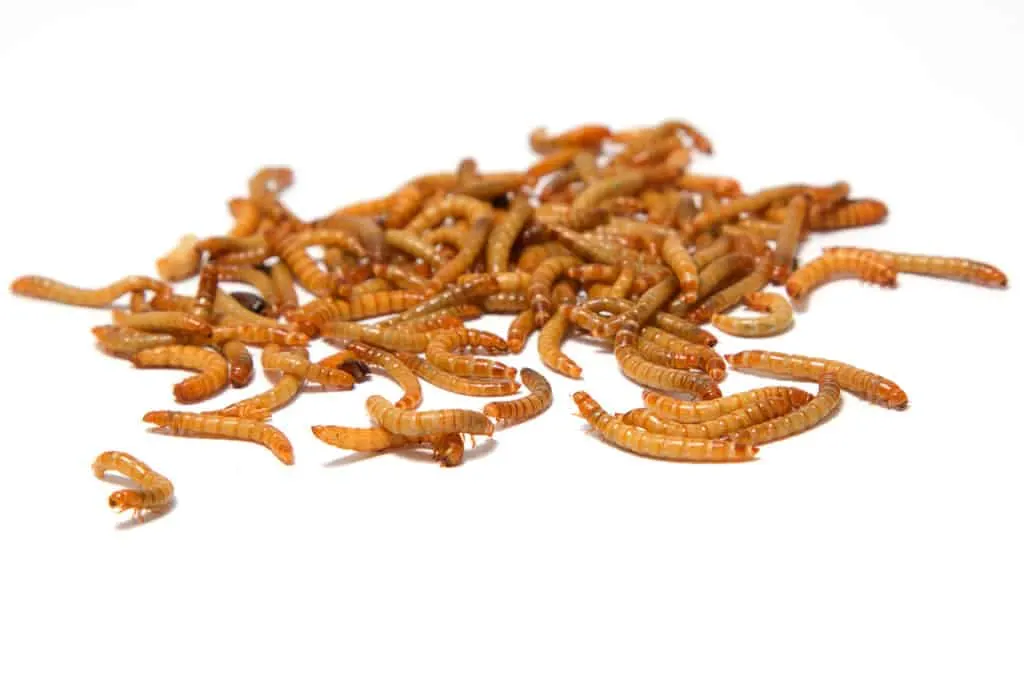
Natural Habitat
In nature, the Darkling Beetle is found in undisturbed humid environments. They prefer dark areas, hence the name “Darkling,” and often hide under rocks or logs. They are scavengers and eat decaying plants and animal material.
Darkling Beetles are more commonly found in stored grain, cupboards, and grain mills, where they feed on whole and ground grains.
Mealworm Life Cycle
Mealworms are the larval stage of the Darkling Beetle.
There are 4 stages in the mealworm life cycle- egg, mealworm, pupa and beetle.
Darkling Beetles mate and lay eggs, which will hatch into tiny

Can Darkling Beetles fly?
There is a lot of debate on whether or not Darkling Beetles can fly. Some mealworm growers online report having witnessed beetles flying, while others state that they cannot fly.
In a 2016 study on mitochondria in Darkling Beetle (Tenebrio molitor) beetle flight muscles, scientists noted that they never saw beetles in their experimental colonies actually fly.
“It is also notable that individuals of the T. molitor colony used in the present study are never observed to fly”
In this study, they kept the Darkling Beetles at 22 degrees C, in a dark and humid location with constant access to food.
Some online articles suggest that the Darkling Beetle will only fly in search of food and won’t fly if they remain well fed.
Darkling Beetles cannot sting or bite. If they were to escape a mealworm farm, they are unlikely to cause any problems. At most, they may find their way into cereal boxes or flour, but they won’t cause any damage to your home or pose any threat to people or pets.
Mealworm egg
The first stage in the mealworm life cycle is the egg.
Darkling beetles reproduce via sexual reproduction. After mating, a female Darkling Beetle lays several hundred eggs over 1-5 months.
The mealworm eggs are very tiny and bean-shaped. While the egg itself is white, it is sticky, so small substrate pieces stick to it. Being so small and covered in substrate, spotting the eggs is difficult.
In about 1-2 weeks, the mealworm eggs will hatch into tiny white

Mealworms
Most
As they grow, they undergo a series of molts where they shed their exoskeleton.
Sometimes a full-grown mealworm will be white after shedding its skin, but it will turn yellow in a few days.
Mealworm pupa
Once the
These pupae cannot move, eat, or drink.
They will remain in this pupal state anywhere from 2 weeks to 4 weeks, again determined by environmental conditions, when they will finally hatching into white or yellowish beetles.

Mealworm beetles
As the beetles mature, they change from white to brown to black in a matter of a few days.
Once they mature, they will mate, lay eggs, and the cycle repeats.
A beetle is the last stage of the mealworm life cycle. Mealworm beetles only live a few short months, but a female beetle can lay several hundred eggs during her lifespan.
Superworms
Superworms are a different variety of Darkling Beetle, Zophobas morio.
While Superworms look similar, they are not as easy to raise. In short, you must separate individual worms to encourage pupating, and their lifecycle takes much longer to complete.
Superworms also have large pincers and will bite.
Why Grow Your Own Mealworms ?
There are lots of reasons to grow your own
Other pets like lizards, hedgehogs, and fish love to eat
Mealworms make a great fishing bait.
And people even eat
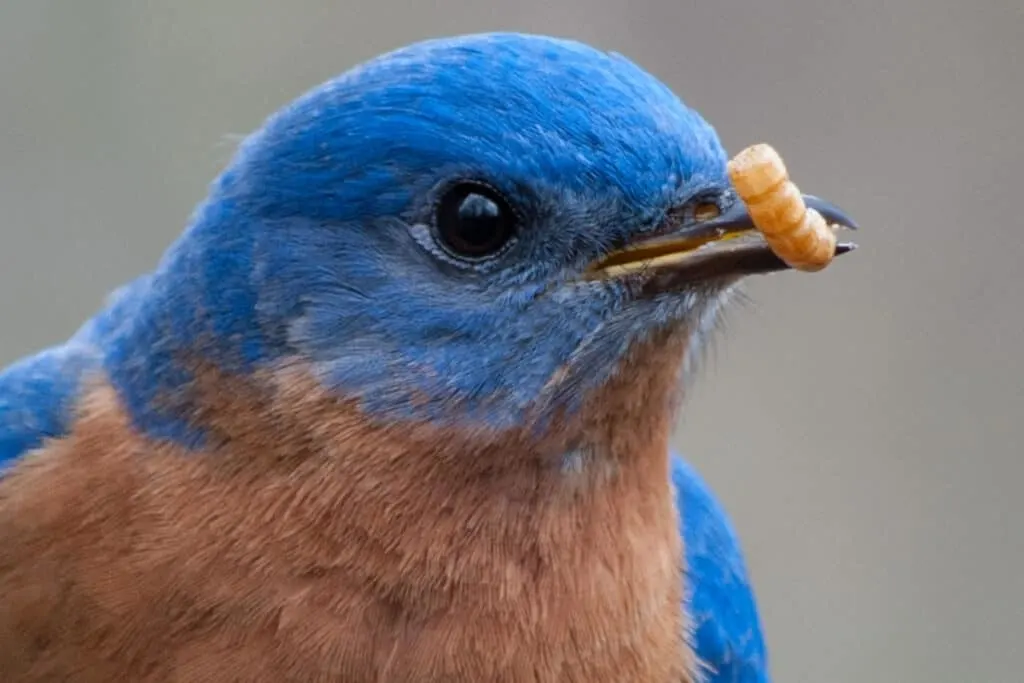
Mealworms for chickens
Mealworms make an excellent treat for chickens.
Mealworms can be used to train chickens to come when called or as a reward for going into the coop at night.
Mealworms are also an excellent supplement when your chickens are molting. Feathers are almost entirely made of protein. Adding some extra protein into your chickens diet helps them grow new feathers quickly.
“The nutritional value of live mealworm is composed of 20% protein, 13% fat, 2% fiber, and 62% moisture, while the dried mealworm’s nutritional value is composed of 53% protein, 28% fat, 6% fiber, and 5% moisture.”
Source
Can baby chicks eat mealworms ?
Yes, chicks can eat
If you decide to give baby chicks treats, they will need a dish of chick grit to help them digest the new foods. They don’t need grit if they are only eating chick starter feed.
Supplies Needed For A Mealworm Farm
In its simplest form, a mealworm farm is a container or series of drawers filled with a layer of substrate and few pieces of potatoes or carrots.
Buying Mealworms
Mealworms can usually be found at your local pet or reptile store. They may also be available at a fishing or sporting goods store. If you don’t have one nearby, I use and recommend ordering from Rainbow
Start with at least 500-1000 worms. The more you start with, the more you can use right away, and the quicker the population will grow.
When I start a new colony, I like to buy 5000 worms.
Helpful Hint
Never buy “giant” or “jumbo”mealworms to start your colony. These are regularmealworms that have been hormonally altered (generally sprayed with juvenile growth hormones to make them grow large but not pupate). Because they have been modified, they will never pupate.
What to feed mealworms
The mealworm colony lives in a substrate of wheat bran or oatmeal. Although it is commonly called “bedding,”
Mealworms cannot live in flour or other fine-milled grains, nor can they live in whole grains like whole or cracked wheat.
Add at least 2 inches but no more than 8 inches of the substrate to your container or tray.
There are several substrate options, and it comes down to personal preference and availability.
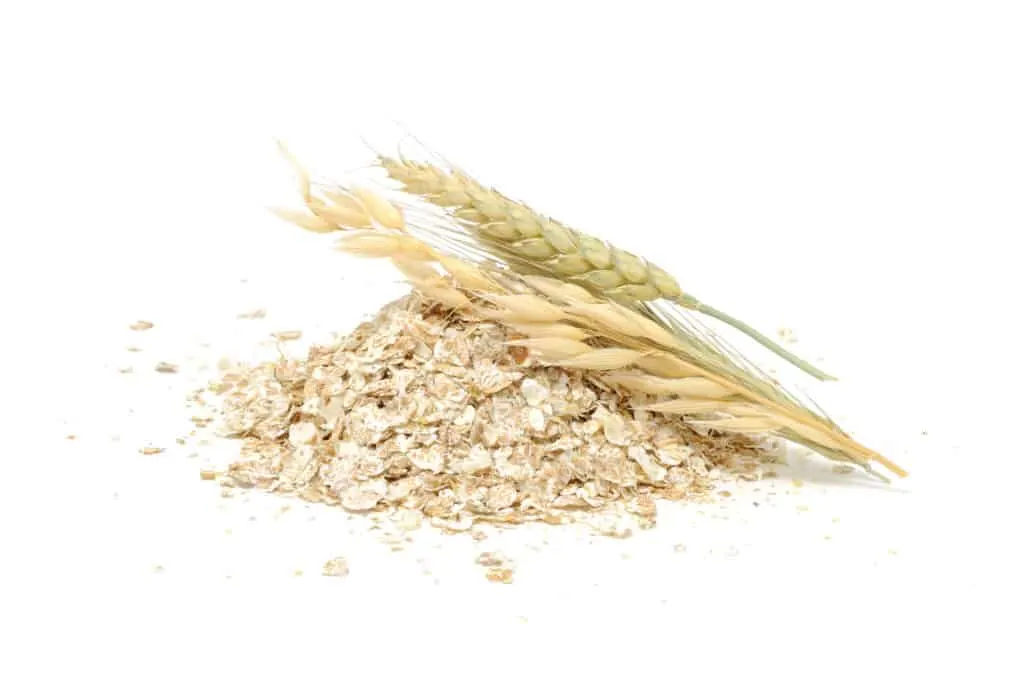
Wheat Bran
Wheat bran is a common choice for mealworm farm substrate. You can usually find 50-pound bags of wheat bran at the feed store (or they can order it for you).
Wheat bran is lightweight and does not compact, so it is easy for the
I prefer wheat bran because it is easier to separate
Wheat bran is also very inexpensive.
Recommended: Central Milling Organic Flaky Wheat Bran
Oatmeal
Oatmeal also makes excellent bedding for mealworm farms.
When choosing oatmeal, choose plain (unflavored) oatmeal.
You can use any type of rolled oats, including instant oats, Old Fashioned Oats, or Quick Cook oatmeal. Avoid steel-cut oats, as they are too thick for the
Oatmeal settles into a dense layer that can be difficult for the
Oatmeal tends to be much more expensive than wheat bran, and it is also harder to harvest
Helpful Hint
It is easier to sift worms from bran than oatmeal
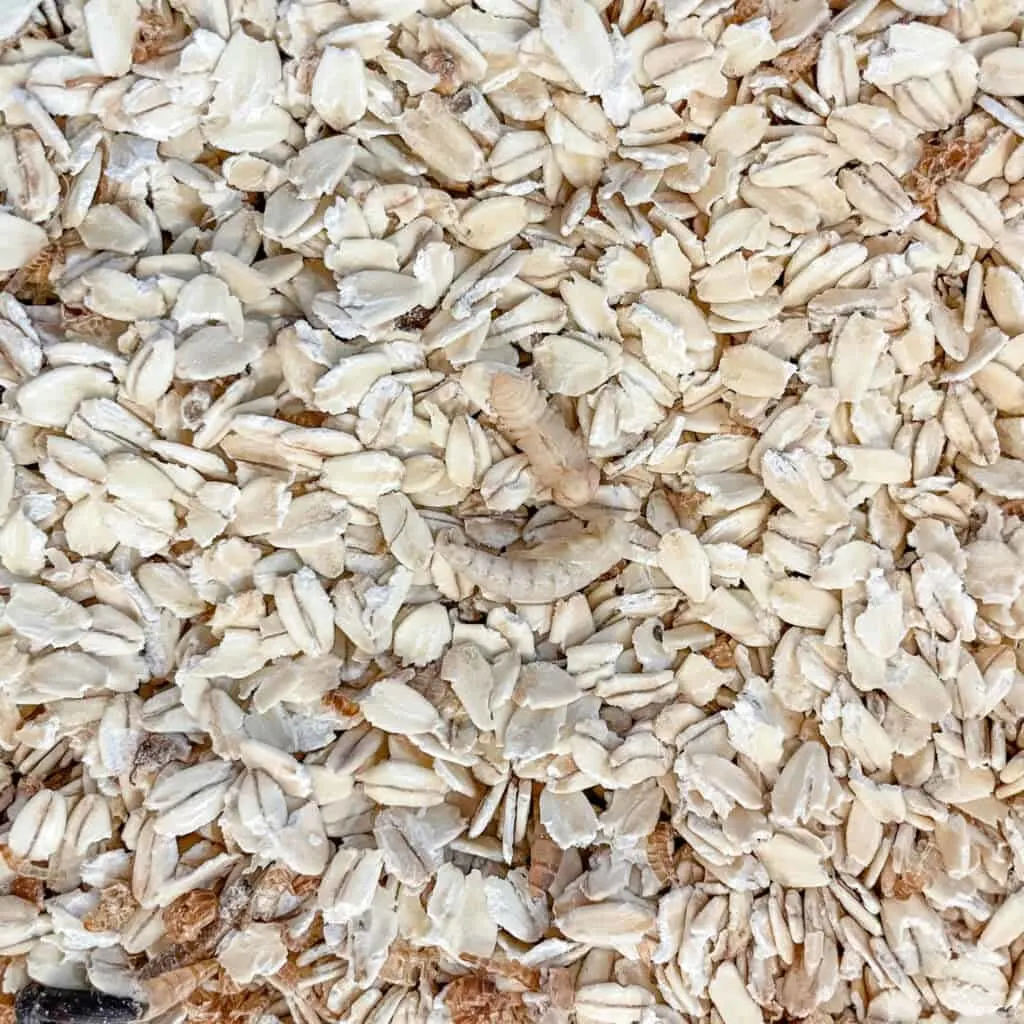
Organic
Whenever possible, opt for organic wheat bran or oatmeal.
Nonorganic options may have trace amounts of pesticides in them that could kill or negatively impact your mealworm farm.
Diatomaceous Earth
Diatomaceous Earth (DE) is sometimes added to feed grains (and chicken feed) to kill insects.
Always check the label and make sure your substrate of choice does not contain Diatomaceous Earth.
HYDRATION
While
The best way to give
Adding too much moisture by misting the substrate or by using watery fruits and vegetables (like an apple or strawberry) could cause mold.
Carrots and potatoes are perfect for giving your
About once or twice a week, give the

Choosing The Best System For Your Needs
There are two main styles of mealworm farms- a single container mealworm colony and a tiered system.
A single container mealworm colony is the easiest way to start your own mealworm farm. Unfortunately, the mealworm beetles can be cannibalistic and will eat some eggs and pupa. By keeping all of the life stages together, you’ll end up with fewer
A tiered system requires a little more space and work, but your mealworm yield will be much higher.
Both options will be included in this post, so it comes down to personal preference.
Single Container Colony
Tiered System
Single Container Mealworm Farm
A single container mealworm farm is just what it sounds like- one container that holds substrate and all stages of the mealworm lifecycle.
This is the easiest way to get started in your mealworm farming adventures.
What You’ll Need:
- Plastic storage container or aquarium
- Drill or mesh & duct tape (or pop rivet gun)
- Wheat bran or plain oatmeal (organic if possible)
- Potato or carrots
- Bucket Sifter
- Mealworms
Container or Aquarium
You can choose any plastic or glass container you prefer.
Look for a wide container that is at least 5 inches deep.
You can use a deeper container and only add a shallow layer of bedding. Understand that deeper does not mean better because
Mealworms prefer a dark environment, so a dark-colored container is preferable to a clear one. If you don’t have a dark-colored container, you can spray paint the outside of the container, cover it in a sheet, or keep the mealworm colony in the dark.

Container Lid
You do not have to use a lid, but it is recommended. Lids help keep the mealworm farm safe from accidents (and curious kids) and keep other critters out, like moths or spiders.
If you choose to use a lid, it needs to have plenty of ventilation.
You can either drill holes in the lid or cut out the middle and replace it with mesh or window screen.
Drilling holes may not provide enough airflow for the mealworm colony. Without enough ventilation, there is a high risk of mold, which can be fatal to your mealworm farm.
A better option is to cut out the middle of the lid and cover the hole with screen material. You can use metal hardware cloth, window screen, plastic canvas, etc.
There are many ways to attach the screen material to the lid, including duct tape, glue (look for one that bonds to plastic), pop rivet, and nuts and bolts. You may need to get creative.
Hot glue doesn’t work well, as it doesn’t adhere to the plastic lid.
DIY Mealworm Farm

A single container mealworm colony is the easiest and least expensive way to start your own mealworm farm.
This is one container that holds the substrate and all stages of the mealworm lifecycle.
Materials
- Plastic storage container or aquarium
- Wheat bran or plain oatmeal (organic if possible)
- Potato or carrot slices
- 5000 Mealworms
- Mesh (optional)
Tools
- Drill
- Drill Bit
- Duct Tape
Instructions
- Find a plastic storage container that's at least 5 inches deep. Wider is better.
- Add at least 2-4 inches of wheat bran or oatmeal to your container.
- If using a lid, drill several ventilation holes or cut out the middle and replace it with mesh.
- Add mealworms
- Add a few slices of potato or pieces of carrot.
- Place your new mealworms farm in a dark, warm location.
Notes
Always choose organic wheat bran, oatmeal, potatoes can carrots whenever possible. Non-organic options may have traces of pesticides that can harm your mealworm farm.
Recommended Products
As an Amazon Associate and member of other affiliate programs, I earn from qualifying purchases.
Tiered Mealworm Farm
We raise
When I first started raising
The tiered system uses drawers to separate beetles and pupae, and rotating drawers to collect and grow
The tiered system has many advantages. Mealworm production is significantly higher, and harvesting is much easier.
With a single container colony,
In the tiered system, especially one with six or more drawers, the mealworm trays are rotated at an interval and then left alone to mature. So all of the

What You’ll Need:
- Drawer system with 3+ drawers
- #8 (1/8″) hardware cloth or window screen
- Duct tape (or pop rivet gun)
- Wheat bran or plain oatmeal (organic if possible)
- Potato or carrots
- Bucket Sifter
- Mealworms
Drawer System
Tiered systems can be made from any plastic drawer organizer, such as these Sterilite drawers or these mobile drawer organizers (which I prefer and use).
You’ll need at least a 3 tier mealworm farm, but between 6 to 20 drawers are best. If you have more drawers, you can raise more
Mealworms and mealworm beetles do not like the light, so if possible, purchase solid colors or black drawers. You can also paint the outside of the drawers or place the colony in a dark location.
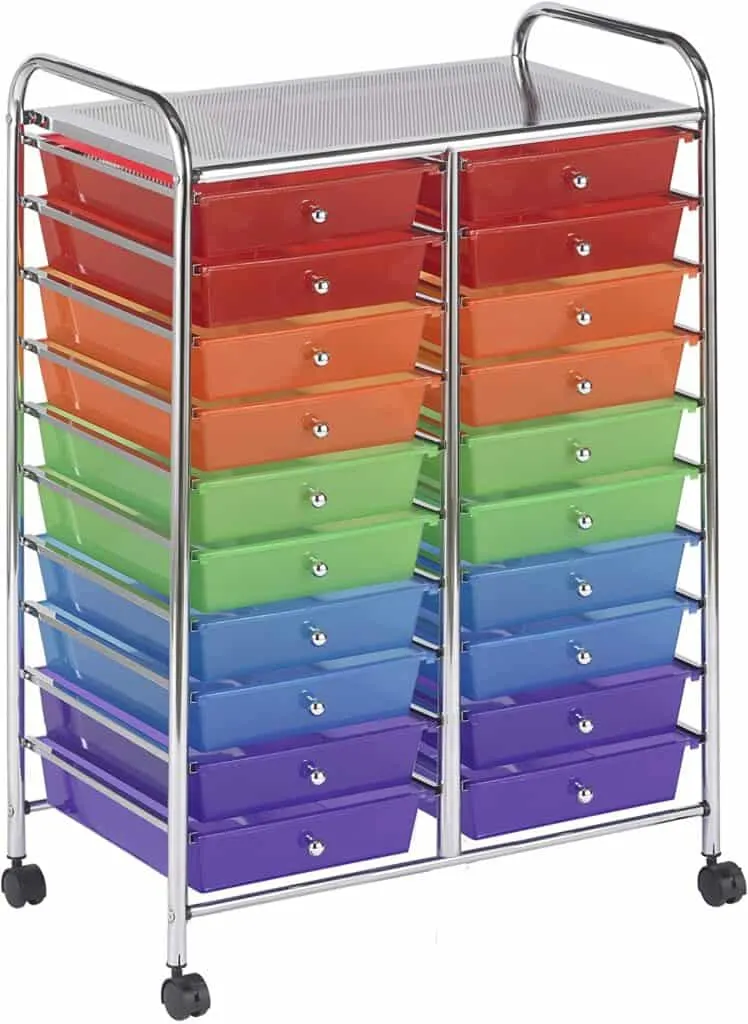
Tiered Mealworm Farm Set-Up
The tiered system has a one time setup to get your mealworm farm started on the path for success.
Beetle Bin
To set up your tiered system, start by carefully cutting out the bottom of one of the drawers and replacing the bottom with the window screen material or hardware cloth.
The Beetle Bin is the only drawer that should have a mesh bottom.
Label this drawer “Beetle Bin,” fill it with 1-2″ of substrate, and add a piece of carrot or potato. This drawer needs to be the first drawer at the top of the system.
Read more about choosing substrate.
When you have beetles, move them to this Beetle Bin. As they lay eggs, beetles will bury into the substrate, depositing their eggs on the mesh bottom.
Eggs and newly hatched
Worm Tray 1
The second drawer in your system, below the Beetle Bin, is Worm Tray 1.
This tray catches eggs and baby
Label this drawer “Worm Tray 1,” fill it with 1-2″ of substrate, and add a piece of carrot or potato.
Pupae Tray
Below Worm Tray 1 is the Pupae Tray. No substrate is needed in this tray.
All pupae should be separated by hand and placed in the Pupae Tray.
When the pupae become beetles, move the beetles to the Beetle Bin.
Newly hatched beetles may also eat the pupae, so it’s important to check this drawer often for beetles.
One solution to this problem is a shelf to place the pupae on. When the mealworm beetles hatch, they fall off the shelf to the bottom of the tray, away from the pupae.
You can make a shelf with an upside-down butter tub or get creative with your own design.
Extra Worm Trays
If you have four or more drawers, additional drawers would be extra Worm Trays. If you are only using a three drawer system, this will not apply.
Fill the extra drawers with 2-4″ of substrate and label them Worm Tray 2, Worm Tray 3, etc.
How It Works
When the beetles in the Beetle Bin lay eggs, the eggs and baby
After a few weeks (or months), swap Worm Tray 1 out with Worm Tray 2. The eggs and young
If you have additional Worm Trays, they can be added to this rotation. The more trays you have, the more often you will be able to harvest.

Worm Tray Rotation
If you only have one Worm Tray, you won’t be able to rotate the drawers.
If you have two or more Worm Trays, they should be rotated regularly to keep the
The interval of worm tray rotation depends on how many Worm Trays your system has.
The more drawers you have, the more often they can be rotated, and the more often they can be harvested.
Mealworms take 3-4 months to be fully grown.
The goal is to rotate the drawers at an interval where they can be set aside for three months and the
If you have two Worm Trays, rotate them every 3-4 months.
3-4 months is the longest you’ll want to leave a drawer to mature because the
If you have more than two Worm Trays, some quick math will help you figure out how often to rotate the drawers.
4 Worm Trays
Each drawer needs to collect eggs and worms and then be set aside for 3-4 months to allow the
So, how often should 4 Worm Trays be rotated so that they can be harvested every three months?
12 months per year divided by 4 Worm Trays equals 3 months.
So, if you have 4 Worm Trays, each drawer should be rotated every 3 months.
This means that every 3 months, you will harvest
16 Worm Trays
What if you have a more extensive system with 16 Worm Trays?
This is easier to figure out by using weeks per year instead of months.
52 weeks per year divided by 16 Worm Trays equals about 3 weeks.
So, every 3 weeks the Worm Tray would be rotated. By the time all of the worm trays are full, the oldest tray will be 3 months old and ready to harvest.
I like to label the Worm Trays with the start and end date to stay on track.
If you’d rather not do the math, there is a table of rotation intervals:
| Number Of Worm Trays | Rotation Interval |
|---|---|
| 2 Worm Trays | Every 3-4 months |
| 3 Worm Trays | Every 3-4 months |
| 4 Worm Trays | Every 3 months |
| 5 Worm Trays | 10 weeks |
| 6 Worm Trays | 9 weeks |
| 7 Worm Trays | 7 weeks |
| 8 Worm Trays | 7 weeks |
| 9 Worm Trays | 6 weeks |
| 10 Worm Trays | 5 weeks |
| 11 Worm Trays | 5 weeks |
| 12 Worm Trays | 4 weeks |
| 13 Worm Trays | 4 weeks |
| 14 Worm Trays | 4 weeks |
| 15 Worm Trays | 3 weeks |
| 16 Worm Trays | 3 weeks |
| 17 Worm Trays | 3 weeks |
| 18 Worm Trays | 3 weeks |
| 19 Worm Trays | 3 weeks |
| 20 Worm Trays | 3 weeks |
Where To Keep Your Mealworm Farm
Once your new
Mealworms like a warm, dark, humid environment.
Temperature & Humidity
Mealworms are ectothermic, meaning their metabolism is impacted by their environment. If kept in a cool or cold location, their metabolism slows down. If kept in a warm place, their metabolism speeds up.
A study in the Journal of the Kansas Entomological Society looked at the effect of temperature and humidity on
- At 25°C (77 degrees F) and 75% humidity, eggs could survive and hatch in 19 days, but at 35°C they hatched in 15 days.
- At low humidity (12% in the experiment), the mealworm eggs dried out and died.
- When kept at 25°C (77 degrees F),
mealworms , pupae, and beetles can survive, even if the humidity isn’t optimal. - Mealworms can be kept at extreme temperatures of 10°C (55 degrees F) and 35°C (95 degrees F) as long at the humidity remains 52% and 75%, respectively.
- Dry and cold conditions resulted in higher death rates for young
mealworms . In contrast, oldermealworms were more likely to die at higher temperatures.
The key takeaway from this study for raising
If kept too cold or dry, your mealworm farm could die or take much longer to mature.
Mealworms thrive in temperatures of approximately 77-80 degrees F and 65-70% humidity. When kept in this range, more eggs will hatch and
Mealworms can survive at temperatures between 55-90 degrees F and 50-75% humidity, but these are not ideal conditions.

Increasing Humidity
If you live in a dry location, you may need to work to raise the humidity for your mealworm farm.
An ultrasonic humidifier is one great option. Ultrasonic humidifiers increase the humidity without raising the dew point (high dew points are when water condenses on surfaces like windows and the air feels muggy).
Avoid warm or cool mist humidifiers, leading to mold or grain mites (more on this in Troubleshooting).
Another option is placing a wet sponge in an open ziplock bag and leaving this open bag in the colony (or one in each drawer). Keeping the sponge in the bag keeps the substrate from getting wet while increasing the humidity in the immediate area.
Lighting
While
If you don’t have a dark place to keep the mealworm farm, you can cover it with a dark sheet or paint the outside of the container to keep it dark inside.
Harvesting Mealworms
Worms take 3-4 months to be full-grown and ready for harvest.
While they can be harvested at any time, it is best to wait until they are full size. But don’t wait too long, as the
Whether you have a single container colony or a tiered mealworm farm, wheat bran, or oatmeal substrate, harvesting is the same.
You can either harvest as needed and use them right away, or batch harvest worms and store them in the fridge.
When you harvest as needed, you’ll use the worms right away. If you are using a tiered system and giving
If you are not ready to use the
By placing them in the fridge, their metabolism slows down significantly, and they won’t turn into pupae. Worms can store in the refrigerator for several months.
To batch harvest, store worms in a shallow container like a sandwich box with a little bit of bran and a well-ventilated lid. Once a week remove the container from the fridge for 24 hours and give the

Separating Worms From Substrate
If you have a single container mealworm farm, or you’d like to cook and eat the
The most common way is to sift the
Separating
Another option is a little more creative. Put an egg carton in a plastic container, and pour a thin layer of substrate in the egg carton. Place this in a bright location. The
If you want to continue raising
Helpful Hint
Never overharvestmealworms . If you take all the worms, there won’t be any left to turn into beetles.
If there are no mealworm beetles, there will be no eggs, which means no worms.
Mealworm Farm Maintenance
Once established, mealworm farms need very little care.
Once or twice a week, give them a piece of carrot or slice of potato for hydration.
During this time, check the colony or drawers for any pupae or beetles. If you have a tiered system, move beetles to the Beetle Bin, and move any pupae to the Pupae Tray.
Also, make sure there are always a few inches of substrate in the container and add more as needed.
Mealworm beetles often enjoy a sprinkling of chicken feed. This gives the beetles a variety of vitamins and minerals and may prevent them from eating eggs or young
Helpful Hint
If you use chicken food, check the tag and make sure it does not contain diatomaceous earth. Many feed producers add diatomaceous earth to prevent pests in the feed and it will slowly kill your entire colony.
Frass
As the
This sandy material is called frass, and simply put, is mealworm poop.
On occasion, you will need to sift out this frass when it gets too deep. The more often you remove the mealworm poop, the healthier your colony will be.
The frass can be removed by separating it from the substrate with a flour sifter or mesh strainer. A bucket sieve also works very well.
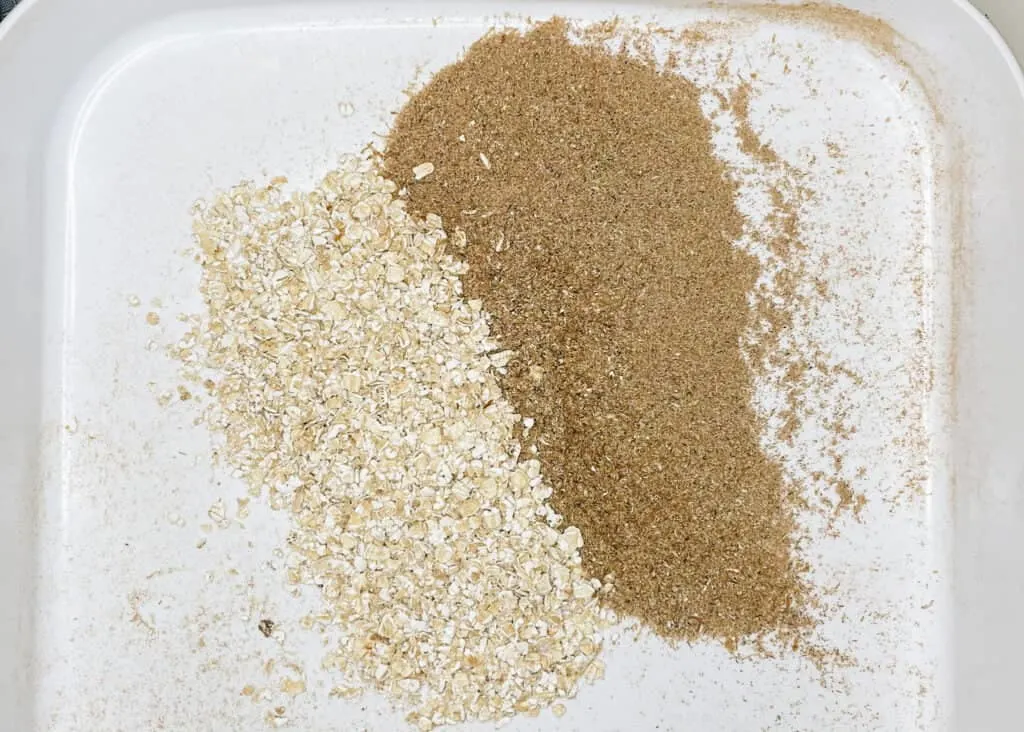
Mealworm Casting For Fertilizer
Don’t throw away the frass!
If you have a single container mealworm farm, save the frass for about a month and add a carrot or slice of potato. You may be surprised to find hundreds of baby
Simply take the potato or carrot and gently brush the young
When there are no more young
Frass contains nitrogen and microorganisms that are plant growth promoters, making it an excellent biofertilizer.
While the NPK of mealworm frass can vary depending on their diet, it is typically around 5-2-2.
Frass also contains copper, zinc, and other beneficial micronutrients for plants.
To use mealworm frass as a fertilizer, sprinkle it as a top dressing or mix it in with the soil when potting plants.
Helpful Hint
Save old frass in a spare container for 1-2 months and see if any baby worms are inside. You’ll probably be surprised; frass is often filled with eggs. Hand separate or sift baby worms and then use frass in your garden. It makes an excellent houseplant or garden fertilizer.
Mealworm Sheddings
As
You will also have to remove these skin sheddings that accumulate periodically.
The easiest way to remove the sheddings is to take the container outside (especially on a breezy day) and gently blow them out.
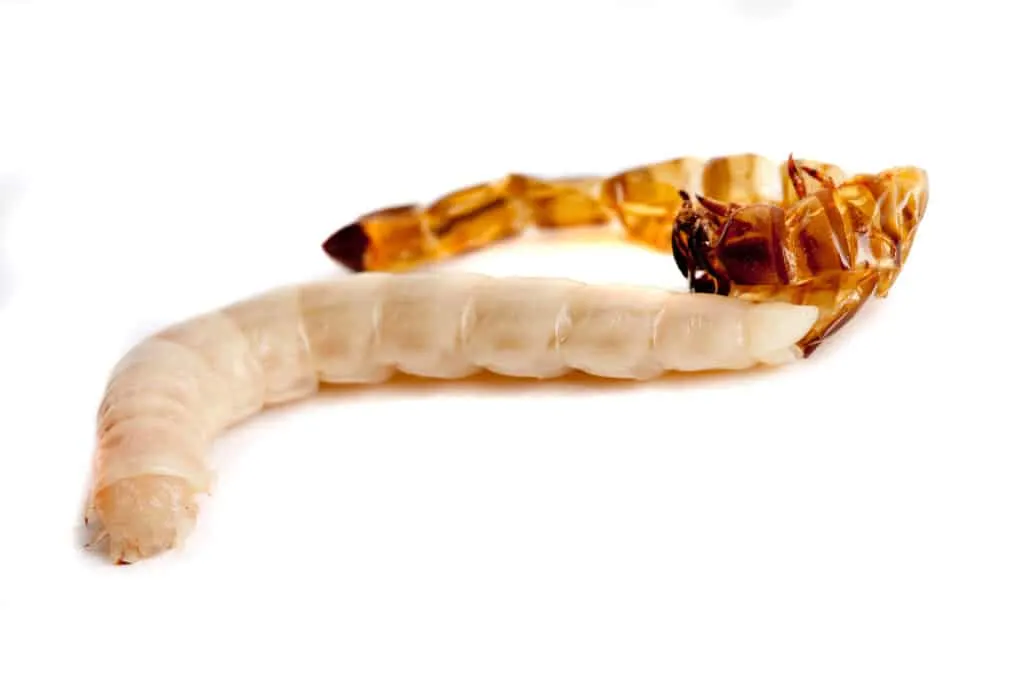
Troubleshooting Common Problems
Mealworm farms are not prone to many problems, but there are a few that can be of concern.
Mold
Mold can be caused by too many watery fruits and vegetables, poor ventilation, or extreme humidity.
If you find mold in your bin, immediately open the top and let it air out. Sift out as many worms and beetles as you can, and throw out all of the moldy substrate.
Before adding new substrate to the container, wipe it down diluted bleach water to kill any mold spores. Rinse well and allow to dry.
Finally, when you return the worms and beetles, try not to add any of the moldy substrate that might be mixed in with the worms.
You can prevent mold by ensuring the containers have excellent airflow, stick to carrots and potatoes for hydration, and keep humidity to 65-70%.
Grain Mites
Grain mites (Acarus siro L.) are microscopic pests that can quickly infest a mealworm farm.
Unfortunately, there is a lot of misinformation online about grain mites in mealworm colonies.
Grain mites first appear as “dust” on the container’s edges and cover the carrot or potato pieces. On closer inspection, you’ll notice that this dust is a moving congregation of white grain mites.
If left untreated, the grain mite population quickly explodes and can cover the mealworm colony in a thick layer. Mites may leave the mealworm farm to search for other food sources, such as the flour in your pantry.

Grain Mites And Humans
Grain mites can be potentially harmful to humans. A 2015 study titled “Mites and the implications on human health” found that grain mites and grain mite feces can cause respiratory problems and, in some cases anaphylaxis.
“The inhalation, contact or ingestion of mites, byproducts of metabolism and mite feces can sensitize susceptible individuals and cause asthma, allergic rhinitis, contact dermatitis, enteritis and lead to anaphylaxis when a large quantity of food infested by mites is ingested.”
[Source DOI:10.3305/nh.2015.31.2.7772]
What Causes Grain Mites?
Grain mite eggs are almost always found in the substrate. They will hatch if the right temperature and humidity conditions are met.
Grain mites are the result of poor ventilation and high humidity. They thrive at temperatures between 20 and 25˚C (68 to 77˚F), and around 80% humidity. While these are optimal conditions, grain mites populations can increase in temperatures between 5-35 °C (41-95 degrees F) and 50-90% humidity. Grain mites cannot survive at lower relative humidities.
If you recall,
Preventing Grain Mites
Grain mite eggs may be killed at very high very low temperatures. A 1984 study, “Resistance of the grain mite Acarus siro L. (Acarina, Acaridae) to unfavourable physical conditions beyond the limits of its development,” found the following:
- Grain mites eggs can be killed when exposed to 40°C (104 degrees F) for 35 minutes.
- Grain mite eggs have a greater tolerance for cold temperatures. Freezing temperatures can kill grain mite eggs when exposed to −10°C (14 degrees F) for 12-14 days.
Heating or freezing substrate may be beneficial for controlling grain mites. Be sure to allow the substrate to reach room temperature before adding it to the colony.
Prevention is the best cure for grain mites. Keeping
Grain Mite Control
If you do experience grain mites, decrease the humidity to below 50% and clean the colony.
Ideally, separate
Wipe down containers and surfaces with hot soapy water. Vacuum the floor and surfaces around the mealworm farm.
Replace the substrate and return the
Keep in mind that potatoes, carrots, or damp sponges can raise the humidity in the colony. If you live in a humid area or are overcoming grain mites, remove potato and carrot pieces after 24 hours to control the moisture in the colony.
Humidity is too low
If you live in an arid environment, you can increase your colony’s humidity by placing a shallow container with a bit of water and a sponge on top of the substrate. Make sure you don’t spill any on the substrate and that the container has plenty of ventilation.

I want to raise mealworms , but I think they are gross!
Some folks have a hard time raising wiggly worms and bugs. If you are one of them, consider these workarounds.
While
If you don’t want to touch them, you can use a spoon to pick them up. Family members, especially children, may also be willing to help. In time you will get used to them.
Pin This

Sources
Abdalbasit Adam Mariod, Mohamed Elwathig Saeed Mirghani, Ismail Hussein, Chapter 50 – Tenebrio molitor Mealworm, Editor(s): Abdalbasit Adam Mariod, Mohamed Elwathig Saeed Mirghani, Ismail Hussein, Unconventional Oilseeds and Oil Sources, Academic Press, 2017, Pages 331-336, ISBN 9780128094358.
Houben, D., Daoulas, G., Faucon, MP. et al. Potential use of mealworm frass as a fertilizer: Impact on crop growth and soil properties. Sci Rep 10, 4659 (2020). https://www.nature.com/articles/s41598-020-61765-x?error=cookies_not_supported&code=df93a002-91a9-4748-b87d-803fe5405783
Punzo, Fred, and J. A. Mutchmor. “Effects of Temperature, Relative Humidity and Period of Exposure on the Survival Capacity of Tenebrio Molitor (Coleoptera: Tenebrionidae).” Journal of the Kansas Entomological Society, vol. 53, no. 2, 1980, pp. 260–270. JSTOR, www.jstor.org/stable/25084029. Accessed 15 Jan. 2021.




Patty Small
Wednesday 6th of March 2024
I am just setting up my mealworm farm. How do you keep the wheat bran in the beetle bin with a hardware cloth bottom? It seems that the bran will just fall through into the bin below.
Thank you
Mohammed arif
Sunday 24th of December 2023
I want mealworm farming so please gide me
Linda Birmingham
Wednesday 27th of September 2023
Thank you so much for this excellent tutorial! You concisely answered all the questions I tried to find answers to on YouTube.
Jamie
Thursday 7th of September 2023
This is ridiculously helpful! Thanks so much! I've referenced this over and over again.
Amber
Tuesday 2nd of May 2023
Hi, I have started a 3 drawer system and I need to remove the bottom of a drawer and replace it with the 1/8th inch screen in your instructions...is it just me or does that seem to be awfully large holes in the screen? Is that the same as cage cloth? Thanx!
Andie
Saturday 20th of April 2024
@Dagny,
I wonder whether using rolled oats would be better in this tray as its firmer and may not fall through so easily.
Holly
Sunday 22nd of October 2023
@Dagny, did you find a way around this? Or just dealing with it?
Dagny
Sunday 16th of July 2023
@Amber, I just made a farm from these instructions, and I used regular window screen and wheat bran as substrate. When I checked the farm today, all the wheat bran from the beetle tray had sifted through the screen into the worm tray below! I think it is the movement of the beetles causing the bran to fall through the screen, even though the screen holes are pretty small. My worm tray has 4" of bran and the beetle tray has none; not sure how to fix this problem. . .